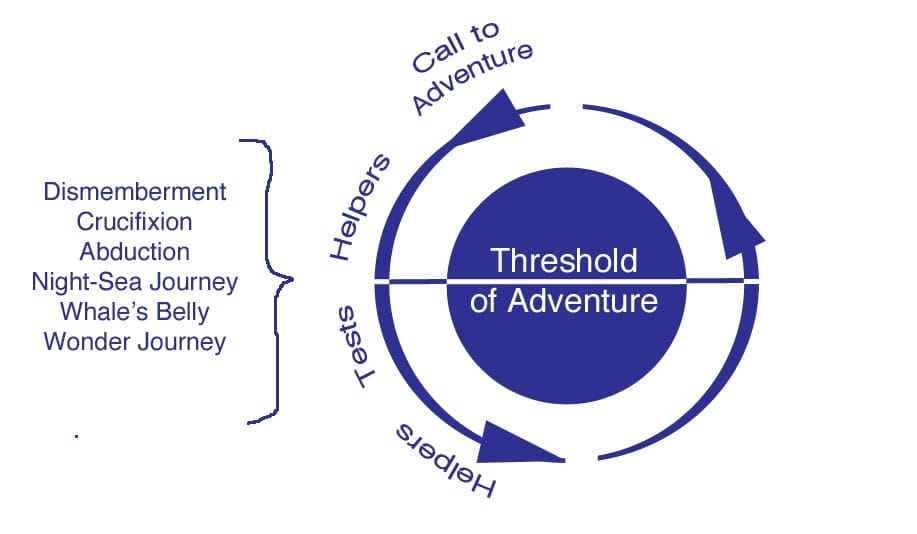The Shamanic Journey & Hero’s Journey (Part I)
Delving deep for the last few months into Joseph Campbell’s “The Hero with a Thousand Faces”, I am astounded by the overwhelming wealth of information Mr. Campbell amassed in his studies. He did this all before the age of the internet. I picture him pouring over ancient texts, seeking myths across continents, sifting through shelves of books, and placing more than one inter-library loan. How he accessed the myths he did and was able to cite every work is beyond comprehension to me. Again, in studying one of the great philosophers I am reminded of the gifts of patience, hard work, and perseverance.
The reason for this exploration is more than purely personal, although as a fellow storyteller I love Mr. Campbell’s work for the sake of his work alone. Upon learning of the hero’s journey and the power of myth a couple of years ago, I immediately began to see connections between the philosophy of Mr. Campbell’s teachings and the shamanic work I conduct with clients. He shares towards the end of the epic volume that in contemporary society “no meaning is in the group – none in the world: all is in the individual” (pg. 334). With ancient mythologies now classified as lies we can no longer use societal myth to connect with meaning on a grand scale. Thus the need for personal myth. Enter the shamanic journey.
Over and over again I see motifs of ancient myth arise in the soul retrievals I perform for clients. All the vast majority of this has happened prior to my reading of this text and integration of the philosophy, so I know for certain that the correlation resides in the collective unconscious. Motifs that are common include the call to adventure, supernatural aid, road of trials, crossing thresholds, sacred marriage, cosmic egg, and the belly of the whale. By entering into this work we are entering into the cosmogenic cycle of birth-life-death-rebirth.
We enter in thinking our goal is to be empowerment and find self-actualization because we live in a culture where the Self is paramount. We want to be the victors in our own lives, to win the boon of peace, abundance, happiness, or love, and bring the treasure home into our everyday. We enter into this cycle without realizing that the first stage of this process requires dissolution. We must let go of what we thought we knew and be cast out from the familiar by embarking on a mysterious journey onto the night-sea of the unconscious. This is the stage where dismemberment, crucifixion, and abduction occur in myth. Whether the dissolution happens willingly or not depends on the circumstances. The same is true in myth. In myths the hero can start out in search of the elixir of life (the fountain of youth), on a quest to rescue a kidnapped loved one or stolen prized possession, involuntarily swept out of her life, or in search of an escape from the boredom of the everyday. Many people come to me for healing thinking that means they will be put back together again, but what they don’t often realize is that I’m taking them apart from what they are attached to. Some people’s lives have been torn asunder already and they are acutely aware of the devastating loss that is occurring. Others come to me fed up, stuck, and ready to cast off the chains. They are begging for the dissolution to come and want a kick-start.
Regardless of the personal motivation or circumstances, the healing comes in pulling up the anchors in the past and following the prompting of the deep well of courage we all possess within. We are acting as our own heroes in this process and heroes are brave souls.
Next come the tests, the road of trials, to point out the inner gifts we have fallen asleep to and to link us further to our omnipresent support systems. Here is where supernatural aid is primary and where people learn to rely on power animals, nature’s messages, and helping spirits. It is much easier to understand the divine when it has form. Old myths used to give the divine form via the characters that played the community stage. Without the old myths to rely on, we have to repopulate the personal stage with closer archetypes. I spend a lot of time working with clients on how to relate to, conceptualize, and communicate with their guides because without this supernatural safety net the road of trials cannot be won. In everyday life, the road of trials looks like the co-worker who takes the credit for what you do, the dead car engine when you’re in a hurry, the inability to find work, complications with selling a house, uncertainty in your marriage, a debilitating illness with no diagnosis or no cure, and much, much more. Internally, the road of trials looks like the utter lack of conviction in your communication, the unending need for control, the nights-long fear of failure, the absolute incapacity to reach out, the ceaseless pursuit of perfection, the undying need to be right, the crippling self-imposed isolation, and much, much more. In the hero’s journey, these are “the rocks that crush the traveler, the reeds that cut him to pieces, the cane cactuses that tear him to pieces, and the boiling sands that overwhelm him” (pg. 58).
It is as if we know on a deep, deep level that this road is coming and before embarking or early on in our healing process we can refuse the call to move forward in fear we won’t make our way. This is why an early and strong connection with power animals and helping spirits can be so pivotal in the voice of the soul winning over that of the ego.
In showing how supernatural helpers make all the difference against unimaginable odds, Joseph Campbell gives the example of Psyche’s mission to rescue her lover, Cupid, from his overbearing mother, Venus. “When Psyche pleaded with Venus, the goddess grasped her violently by the hair and dashed her head upon the ground, then took a great quantity of wheat, barley, millet, poppy seed, peas, lentils, and beans, mingled these all together in a heap and commanded the girl to sort them before night. Psyche was aided by an army of ants. Venus told her, next, to gather the golden wool of certain dangerous wild sheep, sharp of horn and poisonous of bite, that inhabited an inaccessible valley in a dangerous wood. But a green reed instructed her how to gather from the reeds round about the golden locks shed by the sheep in their passage” (pg. 81). And so on the story goes. So many times I come back from shamanic journeys and clients are overwhelmed with how difficult the process was. This trial is necessary and needed for the next stage. We are hungry for the myth of the hero so that we may again connect with our inner hero, the divine act of creation incarnate within ourselves.
This exploration only takes us 1/3 of the way about the round of the hero’s journey.




Thank you, I really enjoyed this. And, it made me find our copy of the book and take it down for another look!
You are so welcome! I love reuniting with old texts. It is so fun to have new insights revealed. Joseph Campbell’s works are especially good at doing that.
Hi Stacey,
I always appreciate your synthesis and insights to complex texts. I really appreciated this part of what you wrote:
“Next come the tests, the road of trials, to point out the inner gifts we have fallen asleep to and to link us further to our omnipresent support systems. Here is where supernatural aid is primary and where people learn to rely on power animals, nature’s messages, and helping spirits. It is much easier to understand the divine when it has form.”
I often tell myself it is my ego that needs to be the receiver of animal messages. That I am just making stuff up to try to make myself feel better about a situation. I think about the fact that these wild animals are just fighting for survival just like we are. That there is nothing special going on and in fact it is quite violent—the natural world. I think I should be doing something to save these wild creatures and our earth, not just “fantasizing ” about the messages they are giving me for my own personal, self-centered journey. Those kinds of thoughts leave me feeling very alone in my trials.
Yes Ginger, this can be a doubt that creeps in when working with animal messengers. Coming from a scientific background, I am familiar with this doubt. But then, for me, the messages pile up so high I can’t ignore them. The animals are there not only to help me with my process, but they are also helping me help others and asking for my help. It is good to keep our ego in check and let go of the need for it to be “all about me” because that opens us up to asking “what do you need?” or “how can I help?”. When we ask the animals these questions they come back with profound answers. The chapter “The Mouthpiece” in my book Gracious Wild is a perfect example of this process. May grace always be with you.
Thanks for your super supportive and intuitive explanation in terms with the appearance of spirit animals in my dream and imagination.
You’re most welcome Grace.
[…] speak at length about the stages and process of the hero’s journey in a three-part series of articles. When considering if the hero archetype as one of your own archetypes, be sure to familiarize […]
[…] Part 1 of The Shamanic Journey & Hero’s Journey we explore the trials the hero goes through to reach the ultimate […]
[…] seemingly insurmountable obstacles. The hero archetype and the warrior have courage in common. The hero has the hero’s journey of many different settings and trials including battles, hardships, and riddles. The warrior lives […]